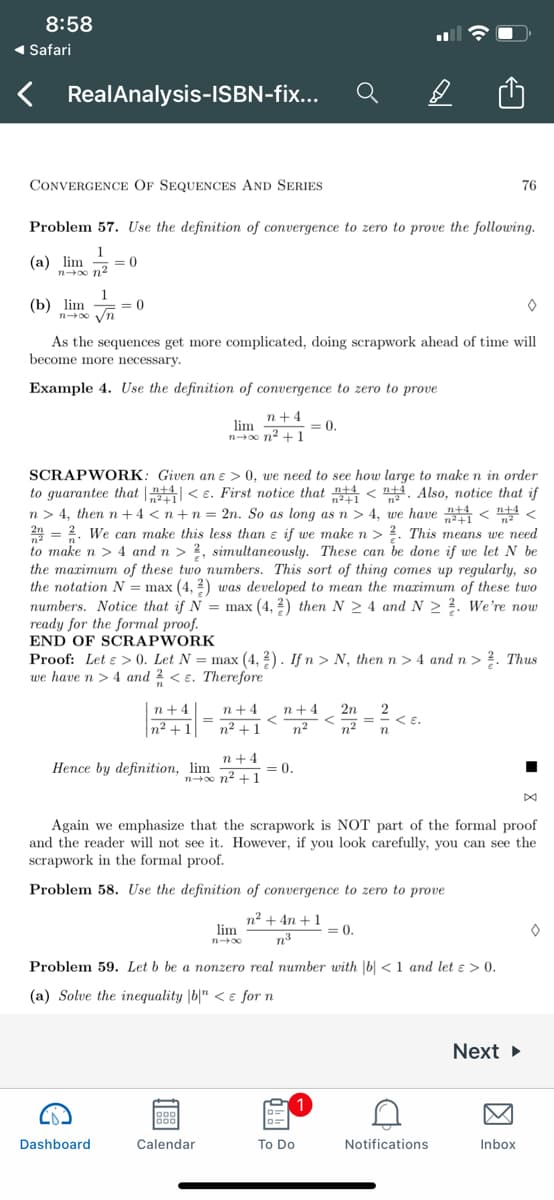Problem 57. Use the definition of convergence to zero to prove the following. (a) lim = 0
Problem 57. Use the definition of convergence to zero to prove the following. (a) lim = 0
Algebra & Trigonometry with Analytic Geometry
13th Edition
ISBN:9781133382119
Author:Swokowski
Publisher:Swokowski
Chapter10: Sequences, Series, And Probability
Section10.1: Infinite Sequences And Summation Notation
Problem 72E
Related questions
Question
100%
#57 part a

Transcribed Image Text:8:58
( Safari
RealAnalysis-ISBN-fix...
CONVERGENCE OF SEQUENCES AND SERIES
76
Problem 57. Use the definition of convergence to zero to prove the following.
1
(a) lim
= 0
n o n2
1
(b) lim = 0
n0 Vn
As the sequences get more complicated, doing scrapwork ahead of time will
become more necessary.
Example 4. Use the definition of convergence to zero to prove
n+4
= 0.
lim
no n2 + 1
SCRAPWORK: Given an e > 0, we need to see how large to make n in order
to guarantee that | < e. First notice that < 4. Also, notice that if
n > 4, then n +4 < n+n = 2n. So as long as n > 4, we have < <
2 = 2. We can make this less than ɛ if we make n > ?. This means we need
to make n > 4 and n > ?, simultaneously. These can be done if we let N be
the maximum of these two numbers. This sort of thing comes up regularly, so
the notation N = max (4, 2) was developed to mean the marimum of these two
numbers. Notice that if N = max (4, 2) then N > 4 and N > ?. We're now
ready for the formal proof.
END OF SCRAPWORK
Proof: Let e > 0. Let N = max (4, 2). If n > N, then n > 4 and n> ?. Thus
we have n >4 and 2 < e. Therefore
n+4
n+4
n +4
2n
n2 +1
n² + 1
n2
n2
< E.
n
n +4
Hence by definition, lim
= 0
no n2 +1
Again we emphasize that the scrapwork is NOT part of the formal proof
and the reader will not see it. However, if you look carefully, you can see the
scrapwork in the formal proof.
Problem 58. Use the definition of convergence to zero to prove
n2 + 4n +1
lim
= 0.
n3
Problem 59. Let b be a nonzero real number with |b| <1 and let ɛ > 0.
(a) Solve the inequality |b|" < e for n
Next
Dashboard
Calendar
To Do
Notifications
Inbox
Expert Solution
This question has been solved!
Explore an expertly crafted, step-by-step solution for a thorough understanding of key concepts.
Step by step
Solved in 2 steps with 1 images

Recommended textbooks for you

Algebra & Trigonometry with Analytic Geometry
Algebra
ISBN:
9781133382119
Author:
Swokowski
Publisher:
Cengage

Algebra & Trigonometry with Analytic Geometry
Algebra
ISBN:
9781133382119
Author:
Swokowski
Publisher:
Cengage